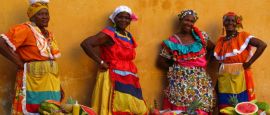Where to stay in Colombia
Hotels in Colombia vary widely in size and quality; they range from pocket-sized hospedajes (guest houses) in humble homes to huge 5-star establishments. It is advisable to choose hotels recommended by the official Colombian Hotel Association (COTELCO) (www.cotelco.org). There is a star grading system similar to that operating in Europe.
Bed and breakfasts in Colombia usually take the form of hospedajes or guest houses, which will generally offer a room with or without breakfast – it depends if you want to pay a little more. These can range from extensions of people’s houses to small hotels. They are usually good value.
Camping is not necessarily available throughout Colombia, as certain areas would be far too dangerous for camping. But there are certain areas in which you’ll find campsites, including along the Caribbean and Pacific coasts (most famously within Tayrona National Park, where hiring a tent is the cheapest form of accommodation) and around Lago Calima. You will also find yourself camping if doing a multi-day hike, such as to the Lost City, but tour companies will provide camping equipment in these cases.
Youth Hostels: Colombia now has an established youth hostel trail throughout the country, with a chain of hostels all providing excellent services, facilities and information about the local areas. This attempt to make Colombia more accessible has helped travellers immeasurably. The locations included in this hostel scheme are Bogotá, Cali, Medellín, Mompox, Salento, Santa Marta, Cartagena, Manizales, Bucaramanga, Villa de Leyva and San Gil. Check out www.colombianhostels.com.co for contact information and maps. Another good resource is HostelTrail (http://hosteltrail.com).
Rural Farmstay: Colombia has a lot of agricultural land, particularly within the Zona Cafetera. It is possible to stay on fincas (farms), either as a working volunteer or as a guest. If you want to work on a farm, expect to pay a small amount for accommodation and meals and to work full days in return. Generally, volunteers are expected to work for at least several weeks, if not months; this is not an easy option but is very rewarding. For examples, see www.hosteltrail.com/cafealban, www.theplantationhousesalento.com and www.wwoof.org.
Self-Catering: Hostels come in all shapes and sizes, and they are not necessarily just for 18-year-olds. The higher-end ones are used by all ages, and are particularly popular because of their self-catering facilities: most will have some sort of kitchen available for guest use, including a fridge to store your food. The bigger cities also have self-catering apartments to rent.
Eco-Resorts: Eco-resorts in Colombia are found in rural areas throughout the country, from the Amazonian jungle to the mountainous farm regions to the coast. You can find eco-lodges dedicated to preserving the environment, eco-farms designed to help the locals develop their land without ruining it, and eco-yoga retreats where you can meditate and eat vegetarian food. Have a look at www.varsana.com, www.estado-natural.com or the eco-lodges in Tayrona National Park for ideas.
Motels: These are common in Colombia but are not the same as US-style motels where you stay overnight, and do not make a good choice for travellers. They rent rooms by the hour, and are commonly used by young couples.
Do you have any Feedback about this page?
© 2025 Columbus Travel Media Ltd. All rights reserved. No part of this site may be reproduced without our written permission, click here for information on Columbus Content Solutions.




 You know where
You know where